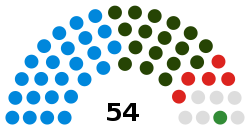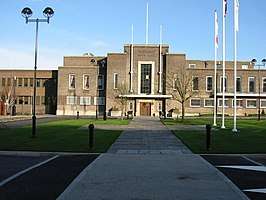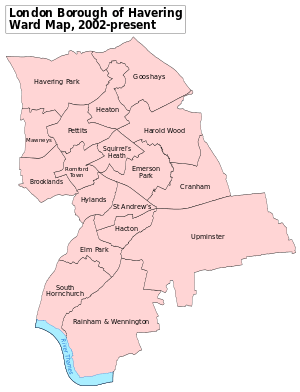Havering London Borough Council
Havering London Borough Council is the local authority for the London Borough of Havering in Greater London, England. It is a London borough council, one of 32 in the United Kingdom capital of London. Havering is divided into 18 wards, each electing three councillors. Since May 2018, Havering London Borough Council has been in no overall control. It comprises 25 Conservative Party members, 23 Havering Residents Association members, 5 Labour Party members and 1 Independent member.[1] The council was created by the London Government Act 1963 and replaced two local authorities: Hornchurch Urban District Council and Romford Borough Council.
Havering London Borough Council | |
|---|---|
| Whole council elected every four years | |
Council logo | |
| Type | |
| Type | London borough council |
| History | |
| Founded | 1 April 1965 |
| Preceded by | Hornchurch Urban District Council Romford Borough Council |
| Leadership | |
Mayor of Havering | Cllr Michael Deon Burton since 16 May 2019 |
Leader of the Council | Cllr Damian White, Conservative since 3 May 2018 |
Chief executive | Andrew Blake-Herbert since 31 March 2016 |
| Structure | |
| Seats | 54 Councillors |
 | |
Political groups | Administration (31)
Opposition (24)
|
| Committees | 7
|
Joint committees | Thames Chase Joint Committee Thames Gateway London Partnership East London Waste Authority London Councils |
| Elections | |
| Plurality-at-large | |
Last election | 3 May 2018 |
Next election | 2022 |
| Motto | |
| Liberty | |
| Meeting place | |
 | |
| Havering Town Hall, Romford | |
| Website | |
| www | |
| Constitution | |
| Constitution | |
History
There have previously been a number of local authorities responsible for the Havering area. The current local authority was first elected in 1964, a year before formally coming into its powers and prior to the creation of the London Borough of Havering on 1 April 1965. Havering replaced Hornchurch Urban District Council and Romford Borough Council. Romford was governed by Romford Urban District Council from 1894 to 1937 and it replaced Noak Hill Parish Council, Havering-atte-Bower Parish Council and Romford Rural District Council in 1934 when the urban district was expanded. Hornchurch Urban District Council was formed in 1926 and replaced Hornchurch Parish Council and Romford Rural District Council in the parish of Hornchurch. In 1934 the urban district was expanded and the council replaced Romford Rural District Council, Cranham Parish Council, Great Warley Parish Council, Rainham Parish Council, Upminster Parish Council and Wennington Parish Council.[2]
It was envisaged through the London Government Act 1963 that Havering as a London local authority would share power with the Greater London Council. The split of powers and functions meant that the Greater London Council was responsible for "wide area" services such as fire, ambulance, flood prevention, and refuse disposal; with the local authorities responsible for "personal" services such as social care, libraries, cemeteries and refuse collection. As an outer London borough council it has been an education authority since 1965. This arrangement lasted until 1986 when Havering London Borough Council gained responsibility for some services that had been provided by the Greater London Council, such as waste disposal. From 1986 to 2000, the London Planning Advisory Committee was run from within the council. Since 2000 the Greater London Authority has taken some responsibility for highways and planning control from the council, but within the English local government system the council remains a "most purpose" authority in terms of the available range of powers and functions.[3]
Powers and functions
The local authority derives its powers and functions from the London Government Act 1963 and subsequent legislation. Havering has the powers and functions of a London borough council. It is a billing authority collecting Council Tax and business rates, it processes local planning applications, it is responsible for housing, waste collection and environmental health. It is a local education authority, responsible for social services, libraries and waste disposal. The council shares responsibility with the Greater London Authority for strategic policies including housing, planning and the environment.[4]
Finances
Havering London Borough Council is the billing authority for Council Tax, and collects a precepts on behalf of the Mayor's Office for Policing and Crime, the London Fire and Emergency Planning Authority the Greater London Authority and Transport for London.[5]
Elections
Electoral arrangements

Wards were established for Havering when it came into existence on 1 April 1965. The first elections of ward councillors took place in 1964.[6] These boundaries were also used for the 1968, 1971 and 1974 elections. For the 1978 elections the ward boundaries were revised.[7] These boundaries were then also used at the 1982, 1986 and 1990 elections.
For the May 1994 elections there were minor adjustments to London borough boundaries, which affected the area and population of some Havering wards.[8][9] These boundaries were also used at the 1998 elections. The current ward boundaries came into effect at the May 2002 elections.[10] They were also used at the 2006, 2010 and 2014 elections.
Summary results of elections
Since 1964 political control of the council has been held by the following parties:[11]
| Party in control | Years |
|---|---|
| No overall control | 1964–1968 |
| Conservative | 1968–1971 |
| Labour | 1971–1974 |
| No overall control | 1974–1978 |
| Conservative | 1978–1986 |
| No overall control | 1986–2006 |
| Conservative | 2006–2014 |
| No overall control | 2014–2018 |
| No overall control | 2018–present |
Leadership
The London Borough of Havering is led by the Leader of the Council and an appointed cabinet formed from the party with majority control of the council. The leader is elected by fellow councillors once every four years following local elections (since 2010, previously annually, with the cabinet being directly appointed by the leader). The current leader is Roger Ramsey who has held the position since 2014. The leadership of the council - once elected - can only subsequently be changed by a vote in favour of such change supported by two thirds of councillors.[12]
Cabinet
The current composition of Havering Council's Cabinet is as follows.
| Party key | Conservative | |
|---|---|---|
| East Havering Residents |
| Post | Councillor | Ward | |
|---|---|---|---|
| Mayor and Deputy Mayor | |||
| Mayor of Havering | Cllr. Michael Deon Burton | South Hornchurch | |
| Deputy Mayor of Havering | Cllr. John Mylod | Saint Andrews | |
| Cabinet members | |||
| Leader of the Council | Cllr. Damian White | Squirrels Heath | |
| Deputy Leader of the Council Cabinet Member for Education, Children & Families |
Cllr. Robert Benham | Brooklands | |
| Cabinet Member for Housing | Cllr. Joshua Chapman | Romford Town | |
| Cabinet Member for Environment | Cllr. Osman Dervish | Pettits | |
| Cabinet Member for Health & Adult Care Services | Cllr. Jason Frost | Mawney | |
| Cabinet Member for Public Protection and Safety | Cllr. Viddy Persaud | Brooklands | |
| Cabinet Member for Finance and Property | Cllr. Roger Ramsey | Emerson Park | |
Mayor
The mayor for 2019/2020 municipal year is Michael Deon Burton.
List of leaders
| Term | Party | Leader | Image |
|---|---|---|---|
| 1967-1971 | Conservative | Cllr. Jack Moultrie |  |
| 1971-1974 | Labour | Cllr. Michael Ward |  |
| 1974-1977 | Conservative | Cllr. Jack Moultrie |  |
| 1977-1978 | Conservative | Cllr. William Sibley |  |
| 1978-1984 | Conservative | Cllr. Jack Moultrie |  |
| 1984-1990 | Conservative | Cllr. Roger Ramsey |  |
| 1990-1996 | Labour | Cllr. Arthur Latham |  |
| 1996-1997 | Residents' Association | Cllr. Louise Sinclair |  |
| 1997-1998 | Labour | Cllr. Wilf Mills |  |
| 1998-2002 | Labour | Cllr. Ray Harris |  |
| 2002-2004 | Conservative | Cllr. Eric Munday |  |
| 2004-2014 | Conservative | Cllr. Michael White |  |
| 2014-2018 | Conservative | Cllr. Roger Ramsey |  |
References
- "Election results". Havering London Borough Council.
- Youngs, Frederic (1979). Guide to the Local Administrative Units of England. I: Southern England. London: Royal Historical Society. ISBN 0-901050-67-9.
- Leach, Steve (1998). Local Government Reorganisation: The Review and its Aftermath. Routledge. p. 107. ISBN 978-0714648590.
- "Local Plan Responses – within and outside London". Mayor of London. Retrieved 9 April 2020.
- "Council Tax and Business Rates Billing Authorities". Council Tax Rates. Retrieved 8 April 2020.
- London Borough Council Elections (1964) Archived 2013-08-22 at the Wayback Machine
- London Borough Council Elections (1978) Archived 2012-08-15 at the Wayback Machine
- Alteration of Status of Local Authorities 1993-1994 Archived 2014-02-21 at the Wayback Machine
- London Borough Council Elections (1994) Archived 2013-08-22 at the Wayback Machine
- London Borough Council Elections (2002) Archived 2013-08-22 at the Wayback Machine
- "Local elections: Havering". BBC News Online. Retrieved 20 December 2009.
- "Council and democracy". Havering London Borough Council.